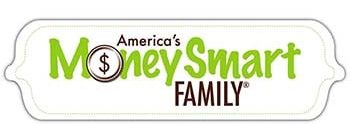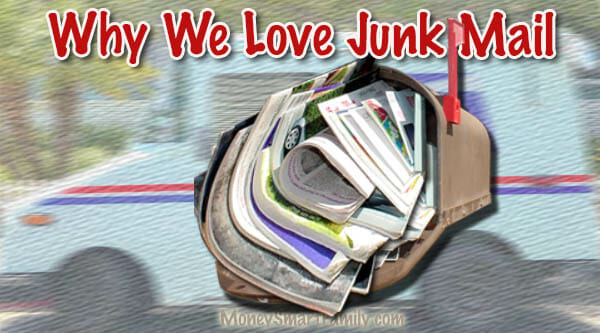We love junk mail. How ’bout you?
We love junk mail, especially insurance agents who send us unsolicited quotes on white paper printed only on one side.
Why? It’s simple.
They’ve just provided us with free paper for our printer.
TABLE OF CONTENTS
How we use Free Junk Mail to Save Money
We have a Brother Multi-Function printer, scanner, copier and fax, but this idea would work with any printer. We have two stacks of paper in bins under the printer: one bin is for new paper, the second bin is paper that has been printed on one side (we call it scrap paper).
Our printer has two trays, but you could do this with a single feed printer too (we did for several years).In the bottom tray of our printer, we put the new, unused paper. In the manual feed tray, we put the “scrap paper,” with the unprinted side up. When we print something that will be only referenced to and then recycled, we print on scrap paper.
If we’re printing something of more significance we print on the new paper. But when printing on new paper, we also use the duplex feature – printing on both sides of the paper. Before we had our first multi-function Brother printer, all we had was an inkjet printer with one paper source. We still had two piles of paper and would load either scrap or new paper depending on what we were printing.
A Funny Story about the Junk Mail Brother Printer
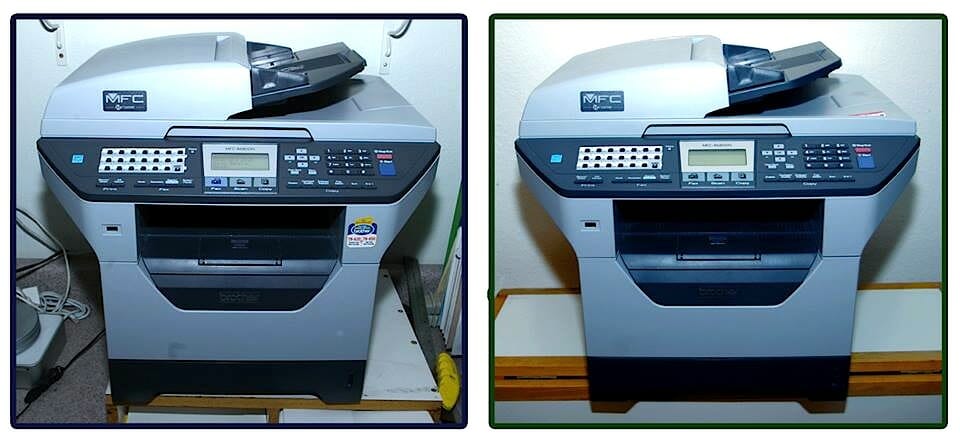
We bought it used a couple of years ago from a seller on CraigsList for $200. The next day we were at Goodwill on their half-price day and found the exact same model Brother printer selling for $28 (full price).
Can you tell which copier/printer cost $200 and which was $14?
The printer on the left cost $200, the one on the right is from Goodwill.
We knew that the printer from Goodwill probably didn’t work, but it appeared to be in good condition, so we bought it to scavenge parts from. For $14 you can’t go wrong. Rollers, gears, trays and other parts break over time and buying replacements can get pricy.
About 4 months ago the fuser mechanism died on the new printer—no big deal, just went to the $14 and pulled the fuser from it and we were up and running in no time (YouTube videos helped us do the repair).
Bottom Line for Recycling & Resourcefulness
1) Recycling Printer Paper is good for the Environment.
Printing on free, recycled paper saves lots of money and trees. Watch your junk mail for reusable paper and clean out your old file folder and your kids school papers. Then print your drafts, disposable ads, articles and anything else that doesn’t need to be presentable, on it.
Caution: We recommend shredding anything with personally identifiable information on it rather than re-using it. You never know when a re-used, re-printed piece of paper might be handed off to someone.
2) Duplex Printers Cut Paper Usage in Half:
Printers with a duplex function can cut your paper usage in half.
Between these two strategies, we rarely have to buy paper, and when we do, we usually wait for a killer sale or massive rebate like OfficeMax’s 1-cent sale for a ream of paper (mail-in rebate required).
More Strategies for Dealing with Junk Mail
We know of numerous ways to deal with mail. Some advocate that you ought to touch your mail only once. Others indiscriminately toss all the mail into the trash. Or how about those news stories in which a house is piled with years’ worth of opened and unopened mail? Isn’t there a middle ground, a more reasonable approach?
How do you handle the mail monster? Do you pile, file or just toss everything – including an occasional bill or two? You may be missing some great deals and costing yourself extra time and anguish over lost items. We know, we’ve done it.
Our mail-handling system has evolved over the years. We now have a three-step process that works for our family. It utilizes a trash can and colored folders to keep the mail under control. As with all our ideas, we realize that no one way of doing anything will work for everyone. We hope we can stimulate your thinking to find methods that free you from spending time on unimportant things. Coming up with a system to handle the mail can save time and money, too.
Designated Postmaster
We’ve decided that one person assuming the responsibility for dealing with the mail works best for us. Annette has taken on this task and does a wonderful job with it. She’s discovered that precision-sorting leads to efficiency, and efficiency leads to a de-stressed life.
Step 1: Trash Can Sort
Every day after getting the mail from the mailbox, Annette stands by the kitchen recycling bin and goes through the pile. She reviews every piece of mail, even bulk mail. She once threw away a bank card that came in an unmarked envelope. This mistake cost her time. She had to call the bank, wade through an endless phone menu of choices, identify herself multiple times and then reorder the card. Real, unwanted, junk mail is tossed into the recycling or regular trash.
Step 2: Hot Stuff
The “Hot File” is a red file folder that contains all bills and other commitments that need to be paid or dealt with. As Annette reviews the mail, she places bills and items that require a response –such as party invitations – into the hot file in our desk-top filing rack. The remainder of the items—ads, magazines, form letters and miscellaneous coupons—go onto a pile at the end of a long counter in the kitchen, where it is dealt with every two to four weeks.
We know that some of you wouldn’t dream of having a pile on your counters. From our research, we’ve found that non-pilers might be either “drawer-stuffers” or “tosser-outers.” The point is that you have a designated location for the mail that you don’t have time to deal with on a daily basis. If you have the time to deal with your mail completely every day, you can pass this article on to someone else or read the other stories in this newsletter.
Step 3: Sorting and Filing Day
“A place for everything, everything in its place.” Of course, Benjamin Franklin, our first postmaster, must have been referring to his personal mail sorting and filing day! Annette picked up the colored folder system from our friend Donna Otto, who teaches a seminar titled “More Hours in My Day.” Our system has been modified and adapted to fit our lifestyle.
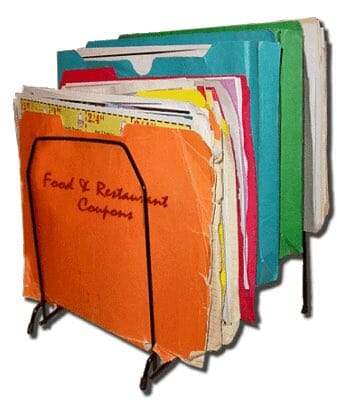
Annette starts the filing process by laying the accumulated mail on our bed –it’s a large enough area to allow the creation of several filing piles. She also puts the recycling bin next to the bed. Then the sorting begins—she makes the following piles and then moves the items to their “final resting place”:
– Magazines – into the bathroom magazine racks;
– Catalogs – stored in an antique cradle and cleaned out every three months or so;
– Receipts – divided into business envelopes labeled with the year and store name for easier retrieval when returning items;
– Food Ads – go into a kitchen cabinet with the coupon caddy;
– Food/Restaurant coupons –into the orange folder for use on date nights or kids reward trips;
– Miscellaneous coupons – into the yellow folder for deals on fun parks, mini-golf and go-carts for the kids, bowling, tree trimmers, dry cleaners;
– Medical Bills/Explanation-of-Benefit forms – red medical folder;
– Dental Bills – blue folder;
– Gardening ideas – green folder;
– Candidate information at election time – gray folder.
Sort Regularly
Because we do this sorting on a regular basis, we throw away very few expired items. Some people may think this process is very labor-intensive, but imagine pulling out all these folders and putting them away each day. Annette’s filing process takes about one hour from start to finish. Beyond time savings, having things sorted where they can be found saves money.
When we want to go out on a date, we pull out the orange folder (Food & Restaurant Coupons), find a two-for-one deal and go out the door. We save hundreds of dollars each year in dinner coupons alone. If a doctor’s office or hospital overcharges our account, having the original paperwork filed and easily located can save us hundreds or thousands of dollars (see our “Medical Maze” article). Most items can be located within three to five minutes.
Minimize the Junk Mail
When we moved into our current home, our mailbox was barraged, daily, with at least three catalogs and other junk mail. The previous owners were virtually on every mailing list known to mankind – Lillian Vernon to Eddie Bauer and everything in between. The mail piled up incredibly fast.
We had to do something about it. We took the offensive and called each catalog and asked to be taken off their list. It took a few months, but eventually, the deluge ceased. Since that time, we have been very careful, whenever information is requested, to ask that our address is kept private – not sold or shared with other companies.
If an undesired magazine or catalog arrives in our mailbox, we call the company’s toll-free number within a couple of days and request to be removed from their list. They may ask why, but they usually comply with our request.
Modified Name on Catalogs or Email Sign Ups
One way we’ve found to keep companies honest is to modify our family name. For instance, if we order a catalog from JC Penney, we use the name, Penney Economides. If that name shows up on other mail, we know the source and can deal with the company and ask them to stop sharing our information.
Another way to limit unwanted mail is through the Direct Marketing Association – Mail Preference Service. This service will remove your name from national advertising mailing lists and should reduce the amount of junk mail you receive. Your name will remain on file with them for five years. But we renew our request every couple of years just to be sure.
Mail your request to:
Mail Preference Service
Attn: Dept. 10425817
Direct Marketing Association
P.O. Box 282
Carmel, NY 10512
The cost is $1 and you can add up to five mailing addresses for your name.
You can do this online, but they charge $5 for the “privilege” of saving postage. Take the time to mail your request.
Phone and E-mail Junk
We use the same approach to minimize solicitor calls and spam e-mails. Our phone number is unlisted – a small monthly fee is well-spent on the peace and quiet. When filling out forms, we don’t give a phone number or e-mail address unless absolutely necessary.
If you use your computer a lot and start receiving unwanted e-mails, don’t respond to be removed from their list – this just tells the computer on the other end that the e-mail address it has spammed is alive and active. It will continue to send stuff and share your information with others. Just hit “delete.”
What’s the value of all this effort?
Less unimportant stuff to deal with on a daily basis. Less junk mail for our landfills. Lower costs to consumers, because we don’t encourage companies to print more catalogs and spend more on mailing costs by remaining on their mailing lists. And of course, more time to spend on things that are really important.
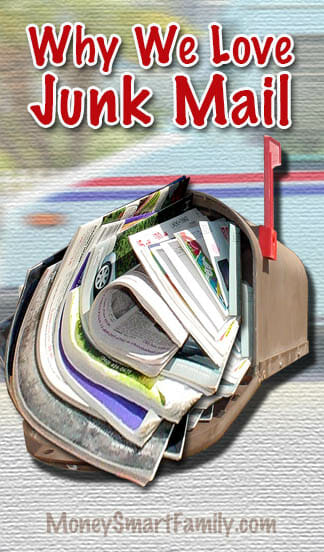
Reader Ideas: This Blog about Junk Mail was Interesting … But
However, I am one of those people who love to get all sorts of junk mail! Let me tell you two reasons why.
1) I open every piece of junk mail and go through it.
You’d be surprised at the freebies you find. In just one week’s worth of unsolicited mail, I received: two pens, free bookmarks, a sheet of “smiley” stickers, several recipes, two sample issues of new magazines, a six-inch plastic ruler, a new penny, and tons of pretty address labels, also lots of coupons!
All this just because I opened my mail!
2) Catalogs are great.
Some of the stationary catalogs come with a free greeting card attached. After paging through them quickly, they go to the craft room, where the colorful pages are used for collages, sticker-making, greeting cards, paper dolls, bookmark making, paper beads, etc. You can even wallpaper an area with them. Several times a year we clean out the stash and put them in the recycling bin.
We also like to make homemade paper, and junk mail scraps are the perfect raw material! As you can see, we enjoy junk mail and can’t wait for the mail carrier each day. I say, keep the junk mail coming! Karen Nescot — Greensburg, PA
